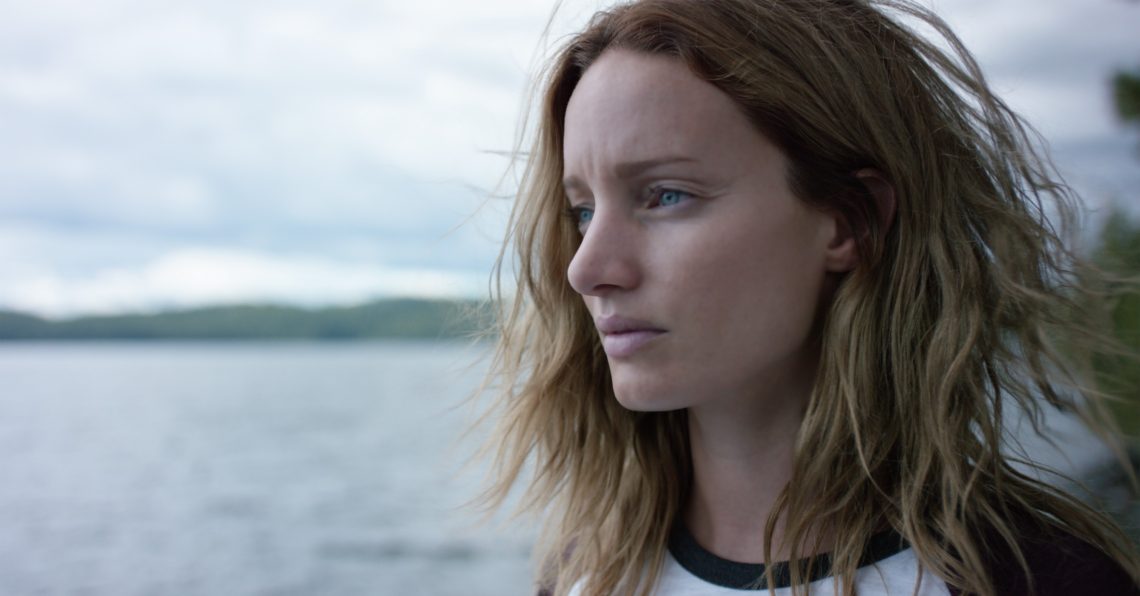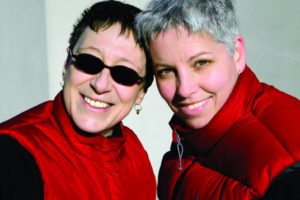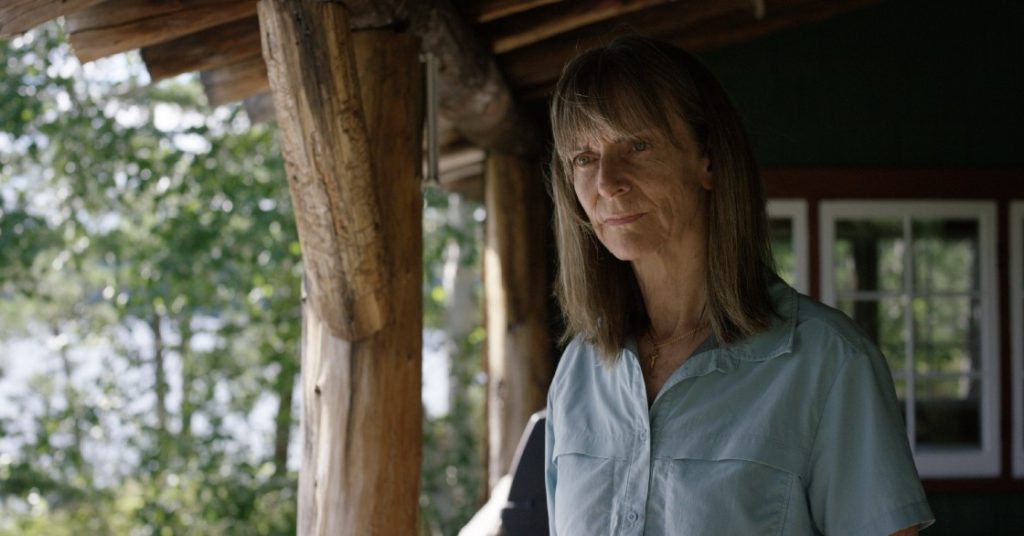
Catch and Release Interview: Dominique Cardona and Laurie Colbert
“We were always let down by the portrayal of lesbians in mainstream cinema. They were invariably broken, apologetic, villainous or some combination of the three — more caricatures than characters. We realized that the only way to change this perception was to make our own films.”
In an isolated cabin in Northern Ontario, with only a few supplies and no way to communicate with the world, Keely awakes. She is pregnant, emotionally fragile and trapped by a religious faction.
CATCH AND RELEASE, based on the Pulitzer Prize-nominated play by Jane Martin, is about a relationship. While Keely and Du begin at opposite sides of an argument, through conversation they begin to understand each other and unite over the true enemy of the story —men.
“The play had such a powerful message of how our basic humanity can bridge even the most entrenched ideological differences. We were really struck by that.” —Laurie Colbert
Anchored by a strong lead performance by Laurence Leboeuf, CATCH AND RELEASE is a tense psychological thriller with a message that is still relevant in these trying times.
CATCH AND RELEASE will be available on iTunes Canada July 14.
Tell us a little bit about yourself, and how you got involved with filmmaking.
 Laurie Colbert: Dom and I met 32 years ago and bonded, to a large degree, over our shared love of film. We never thought of being filmmakers — Dom was a civil servant; I was working as an English teacher. While living in Paris, we started to meet a lot of filmmakers and saw hundreds of films at the French Cinematheque and the Creteil Women’s International Film Festival.
Laurie Colbert: Dom and I met 32 years ago and bonded, to a large degree, over our shared love of film. We never thought of being filmmakers — Dom was a civil servant; I was working as an English teacher. While living in Paris, we started to meet a lot of filmmakers and saw hundreds of films at the French Cinematheque and the Creteil Women’s International Film Festival.
We were always let down by the portrayal of lesbians in mainstream cinema. They were invariably broken, apologetic, villainous or some combination of the three — more caricatures than characters. We realized that the only way to change this perception was to make our own films. So, we started shooting our first film together in 1992, Thank God I’m a Lesbian, a documentary that shows the full experience of lesbians, including the luminosity and the joy. After making our first film that landed at TIFF, we made My Feminism and got to work with Gloria Steinem, bell hooks, Urvashi Vaid, Judy Rebick and other leading feminist thinkers of that era. It’s kind of bittersweet that film is as timely today as when we make it over twenty years ago.
Tell us about Catch and Release, and why you decided to adapt the play into a feature film.
LC: I first started itching to write a road trip movie even before my first feature. We first read Keely and Du 20 years ago. The play had such a powerful message of how our basic humanity can bridge even the most entrenched ideological differences. We were really struck by that and have followed the path of the play since then. It was a long journey from that first experience with the work to optioning it for a film adaptation — Jody Foster had the film rights for 7 years and it was also optioned by a number of other production companies before we finally acquired the rights in 2014.
The featureless basement where the play takes place is so integral to the story. We wanted to translate that sense of captivity to a remote island. So, the first thing we had to do to get the option was to convince the playwright, Jane Martin, that our vision would not only support but enhance the work.
Why did you change the name from the original version of Keely and Du to Catch and Release?
LC: To be honest, it was a marketing decision that we made after much consultation, including with U.S. festival juries who were starting to recognize the film with awards and wanted it to be seen. As filmmakers, our goal is always to bring our films to the widest possible audience. The stage play, Keely and Du, is 27 years old. It was very successful at the time — well-reviewed and nominated for a Pulitzer. That being said, the title doesn’t carry a lot of resonance for this generation. With so many film experiences to choose from on so many platforms, the title becomes more and more important in terms of getting a film in front of your audience.
Fishing plays prominently in the film. One of the characters catches, cleans and cooks fish as a means of sustenance. Catch and release fishing, which is done purely for sport, involves terrorizing a fish and throwing it back with a permanent scar from where the hook is removed. End of metaphor.
Why did you base the film in Northern Ontario? And how long did you have to shoot in that location?
LC: Northern Ontario is one of the most beautiful places on earth with expanses of untouched wilderness dotted with thousands of lakes. There’s also a foreboding in that beauty — a sense of isolation from everyone and everything. We knew we wanted to set it on an island, with water taking the place of concrete walls. The further north we took our location search, the closer we got to seeing the vision of the film we wanted to make.
Being that far removed from modern conveniences (including roads) was definitely a daunting proposition for a film shoot, but the amazing local talent in Temagami made it possible. From transporting actors and equipment between islands and making sure our essential facilities were clean and operable to feeding the crew and keeping us safe during some pretty dodgy weather, we could not have shot this film in 20 days without the support of Cathy Dwyer and her local crew.
Catch and Release is very relevant to the conversations happening around the issue of abortion and women’s rights. What do you hope people take from the conversations that happen in the movie?
LC: As feminists, clearly, we have a strong opinion on reproductive rights. That being said, reproductive freedom is a basic human right and that really can’t be debated anymore. The notion of women’s bodies as property of the state is still played out around the world with varying degrees of barbarity. In the USA, it comes in waves. Despite a clear separation of church and state, there’s a pandering to religious fundamentalism when those voters can determine the balance of power.
Abortion is a hugely polarizing issue that will continue to divide. This film is really about relationships — the shared human experience that can transcend anything we accept as the truth. What we hope people take away is the idea that viewpoints are always transitory and dependent on the environment and circumstance.

How did you prepare with the actors, especially Laurence Leboeuf as Keely, in order to get the performances and deal with such difficult subject matter?
LC: We really didn’t. As emotionally triggering as the subject matter is, it’s secondary to the relationships we wanted to explore. From optioning the source material to final edit, this film took almost 5 years to make. The casting process alone almost defeated us. When we finally headed to the location, we knew we had the cast we needed. From that point, our job was to make them feel safe enough to deliver the performances we knew they were capable of.
Speaking of the cast, we felt privileged to be working with such a talented and experienced group of artists from theatre and film. Laurence Leboeuf, Nancy Palk, Aidan Devine and Peter Mooney were all joys to collaborate with. The politics of the film was not an issue — how to tell this particular story was what motivated everyone on set.
The camera seems to focus a lot of Keely’s body, can you talk about why you made those choices?
LC: Shame is such a powerful tool in terms of objectifying or controlling anyone, especially women. As a captive, the one thing Keely owns is her body. It was really important to us to show that she refuses to associate her body or her sexuality with shame. For example, there’s a scene where she takes off her top in front of Du. Du clearly feels shame, but she cannot project it onto Keely.
Can you tell us about some/all of the other amazing womxn/non-binary people who worked on this film?
LC: Our lead producer, Jennifer Mesich ran the set and did an amazing job coordinating all the people who worked on the shoot. The set was relaxed (to the point of some naked sunbathing at lunchtime), but always on schedule. Because of that precision, we were able to relax (somewhat) and really enjoy our time together in what was a once in a lifetime location.
Tell us about why you are a feminist and why it’s important to your filmmaking.
LC: We believe that being a feminist is not so much a choice as an imperative for anyone who has the luxury of free speech, which we do as Canadians. The reason we became filmmakers is that we felt compelled to share the reality of women’s experience. For us, feminism is really about self-determinism and an end to racial, gender and sexual oppression, which can’t exist as long as there is a politic that seeks to control women’s bodies.
What are you working on now/next?
LC: Right now we’re in the planning stages of a film or TV series about a gay tween who is becoming aware of her sexuality in a time where social media is trying to define it for her. As the daughter of recent immigrants, her journey is complicated by her parents’ support of movements (#MeToo, #BlackLivesMatter) that she knows she should care about but doesn’t fully understand.
Finally, recommend one #MUFFApproved film for our blog readers.
LC: We’re both in love with The Woman Who Loves Giraffes directed by Alison Reid. It’s a beautifully-crafted documentary about scientist Anne Innis Dagg, arguably the first person to study an animal in the African wild, who pushed through aggressive sexism to follow her passion only to end up in virtual obscurity. The film is an amazing reclamation of her pioneering work in the field of giraffe biology and behaviour.
Keep up to date with Catch and Release: Twitter
*This post was originally featured on The MUFF Society.*

